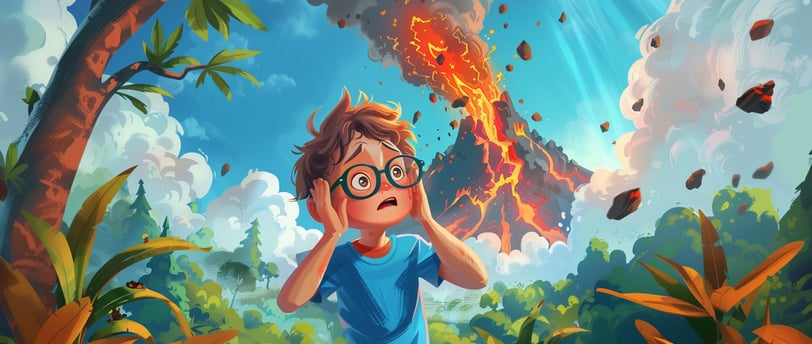Exploring Volcanoes: A Fiery Adventure for Curious Minds
Discover the excitement of volcanoes with our fiery adventure guide! Perfect for kids and educators alike, packed with fun facts and learning tips.
Steve Lewis
9/6/20243 min read
Introduction to Exploring Volcanoes: A Fiery Adventure
Volcanoes are one of the most thrilling natural phenomena on Earth. From the explosive eruptions of fiery lava to the towering volcanic mountains, there’s something magical about these powerful forces of nature. Whether you're a budding scientist or just curious, "Exploring Volcanoes: A Fiery Adventure" will ignite your fascination with the Earth's volcanic wonders.
This guide is perfect for kids, parents, and educators alike, offering fun facts, safety tips, and a journey into the mysteries of volcanoes!
What Is a Volcano? (Understanding the Basics)
Volcanoes are essentially mountains that can erupt, spewing out molten rock (lava), ash, and gases from deep within the Earth. This natural process can create stunning landscapes, but it can also be dangerous. Exploring Volcanoes: A Fiery Adventure helps you understand the science behind these natural formations and how they shape our planet.
The Anatomy of a Volcano
A volcano is made up of several key parts: the magma chamber (where the molten rock is stored), the vent (the opening), and the crater (the top where eruptions occur). The pressure from deep within the Earth pushes magma up, creating an eruption that can either be explosive or calm. You’ll discover more about these in our Exploring Volcanoes: A Fiery Adventure guide!
Types of Volcanoes: Shield, Cinder Cone, and Composite Volcanoes
Not all volcanoes are the same! The three main types are:
Shield Volcanoes
These have gentle, sloping sides and erupt less violently. Famous examples include Mauna Loa and Mauna Kea in Hawaii.
Cinder Cone Volcanoes
These are small, steep-sided volcanoes that form quickly from lava fragments. They're short-lived but impressive!
Composite Volcanoes (Stratovolcanoes)
The most iconic and dangerous, composite volcanoes like Mount St. Helens and Mount Fuji can have devastating eruptions. Our Exploring Volcanoes: A Fiery Adventure explains more about the hazards and beauty of these formations.
Why Do Volcanoes Erupt? (Understanding the Science)
In Exploring Volcanoes: A Fiery Adventure, we dive deep into the reasons behind volcanic eruptions. It's all about the Earth's tectonic plates and the intense heat deep within the planet. When magma (molten rock beneath the surface) builds up pressure, it has to escape somewhere, and that’s where eruptions come into play.
How Plate Tectonics Influence Volcanoes
The Earth's crust is made up of giant plates that are constantly moving. When these plates collide or pull apart, they create openings for magma to rise to the surface. The result? A fiery volcanic eruption! You’ll learn more in Exploring Volcanoes: A Fiery Adventure.
Famous Volcanoes Around the World
Some volcanoes have captured the imagination of people all over the world. In our guide, we explore some of the most famous ones, including:
Mount Vesuvius
This Italian volcano buried the ancient city of Pompeii in AD 79, a historical event that has fascinated archaeologists for centuries.
Mount Fuji
Japan's iconic volcano is both a symbol of natural beauty and an active geological wonder.
Kilauea
One of the most active volcanoes on Earth, located in Hawaii, Kilauea offers stunning lava flows and geological formations.
Fun Facts About Volcanoes
Did you know that more than 80% of the Earth’s surface is volcanic in origin? Or that the largest volcano in the solar system is on Mars? In Exploring Volcanoes: A Fiery Adventure, we’ve included plenty of fun and surprising facts to spark the curiosity of young learners and adventurers!
How to Stay Safe Around Volcanoes
While volcanoes are fascinating, they can also be dangerous. Our guide includes essential tips on how to stay safe when visiting active volcanic areas. Always follow local safety regulations, and remember to admire from a safe distance!
Conclusion
Volcanoes are a true testament to the power and beauty of nature. Whether you're reading "Exploring Volcanoes: A Fiery Adventure" as a learning tool or just for fun, there’s so much to discover. From understanding how they form to witnessing their breathtaking eruptions, volcanoes offer a unique way to appreciate the Earth's raw energy.
FAQs About Volcanoes
What is the most dangerous volcano in the world?
One of the most dangerous volcanoes is Mount Vesuvius in Italy, due to its history of explosive eruptions and the dense population nearby.
How can I learn more about volcanoes?
Our guide, Exploring Volcanoes: A Fiery Adventure, is a great starting point! Additionally, many science museums and online educational platforms provide interactive resources.
Do all volcanoes erupt?
Not all volcanoes are currently active. Some are dormant (inactive for a long time) or extinct (unlikely to erupt again).
By the end of Exploring Volcanoes: A Fiery Adventure, you’ll feel ready to explore the wonders of these geological marvels, whether in person or through learning!


